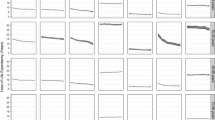Abstract
Cancer is one of the most serious health concerns facing the nation. Health care policy makers who determine cancer research and treatment priorities must analyze death rates as an indicator of public health priorities. Two additional indexes that account for premature death include years of potential life lost (YPLL) and potential years of life lost per death (YPLL/D). Data for ten leading causes of cancer death in men from 1974–1983 were analyzed and the YPLL and YPLL/D corresponding to these cancers was calculated. Each cancer was then ranked from most to least significant according to each index. The analyses show that using YPLL and YPLL/D to evaluate cancer death in men results in rankings that differ from those obtained when using death rates alone. The premature death indexes, when used in combination with traditional mortality indexes, would enhance the data base used by funding agencies who select and evaluate cancer treatment and prevention programs.
Similar content being viewed by others
References
Perloff JD, Lebailly SA, Kletke PR, Budetti PP, Connelly JP: Premature death in the United States: Years of life lost and health priorities.J Pub Health Pol 5:167–184, 1984.
Dempsey M: Decline in tuberculosis; the death rate fails to tell the entire story.Amer Rev of Tubercul 86:157–163, 1947.
Doughty JH: Mortality in terms of lost years of life.Can J Public Health 17:134–150, 1951.
Haenszel W: A standardized rate for mortality defined in units of lost years of life.Am J Public Health 40:17–26, 1950.
Christophersen ER: Automobile accidents: Potential years of life lost.Pediatrics 71:855–856, 1983.
U.S. Department of Health and Human Services, Centers for Disease Control: Introduction to table V, premature deaths, monthly mortality, and monthly physician contacts - United States.Morbid Mortal Weekly Rep 31:109–117, 1982.
U.S. Department of Health and Human Services, Centers for Disease Control: Premature mortality in the United States.Morbid Mortal Weekly Rep (Suppl. 35:1–11, 1986.
Hamburg DA, Elliott GR, Parron DL (eds):Health and behavior. Washington, DC, National Academy Press, 1982.
Silverberg E: Cancer in young adults (ages 15–34).CA: A Cancer Journal for Clinicians 32:32–42, 1982.
Dahl O: Testicular carcinoma: A curable malignancy.Acta Radiolog Oncol 24:3–15, 1985.
Einhorn LH: Testicular cancer as a model for a curable neoplasm.Cancer Res 41:3275–3281, 1981.
Friman PC, Finney JW, Glasscock SG, Weigel J., Christerphersen ER: Testicular self-examination: Validation of a training strategy for early cancer detection.J Appl Behav Anal 19:87–92, 1986.
Goldenring JM, Purtell E: Knowledge of testicular cancer risk and need for self-examination in college students: A call for equal time for men in teaching of early cancer detection techniques.Pediatrics 74:1093–1096, 1984.
Cummings MK, Lampone D, Mettlin C, Pontes JE: What young men know about testicular cancer.Prev Med 12:326–330, 1983.
Thornhill JA, Conroy RM, Kelley DG, Walsh A, Fennely JJ, Fitzpatrick JM: Public awareness of testicular cancer and the value of self-examination.Brit Med J 293:480–481, 1986.
Silverberg E. Cancer statistics, 1985.CA: A Cancer Journal for Clinicians 35:19–36, 1985.
Silverberg E, Lubera J: Cancer statistics, 1987.CA: A Cancer Journal for Clinicians 37:2–20, 1987.
National Center for Health Statistics:Vital Statistics of the United States 1974–1983. Washington, DC, U.S. Government Printing Office.
Romeder JM, McWhinnie JR: Potential years of life lost between ages 1 and 70: An indicator of premature mortality for health planning.Int J Epidem 6:143–151, 1977.
Author information
Authors and Affiliations
Additional information
Patrick Friman, Ph.D. is Assistant Professor of Pediatrics, University of Nebraska Medical School and a staff psychologist at the Meyer Children's Rehabilitation Institute. Jack Finney, Ph.D. is Assistant Professor of Psychology, Virginia Polytechnic Institute and State University. Michael Leibowitz, Ph.D. is Associate Professor of Pediatrics, University of Nebraska Medical School and Deputy Director for Programs at the Meyer Children's Rehabilitation Institute. The preparation of this manuscript was supported in part by Project 405, Maternal and Child Health Services, Department of Health and Human Services and the National Cancer Institute (CA 47565). The authors gratefully acknowledge Bruce A. Buehler, M.D., Ramon M. Fusaro, M.D., Pam M. Wendell, M.D., George Williams, M.A., and William C. Duckworth, M.D. for providing invaluable comments on earlier drafts of this manuscript.
Rights and permissions
About this article
Cite this article
Friman, P.C., Finney, J.W. & Leibowitz, J.M. Years of potential life lost: Evaluating premature cancer death in men. J Community Health 14, 101–106 (1989). https://doi.org/10.1007/BF01321540
Issue Date:
DOI: https://doi.org/10.1007/BF01321540




